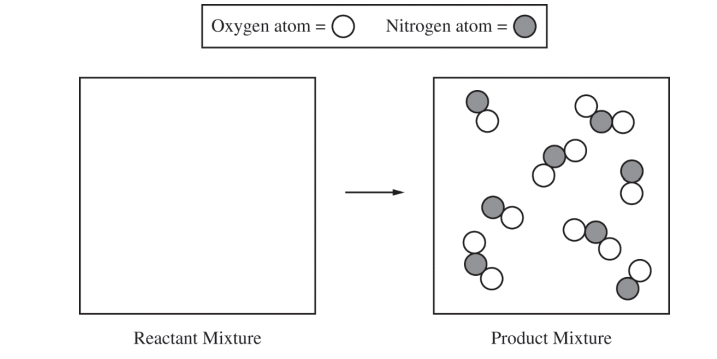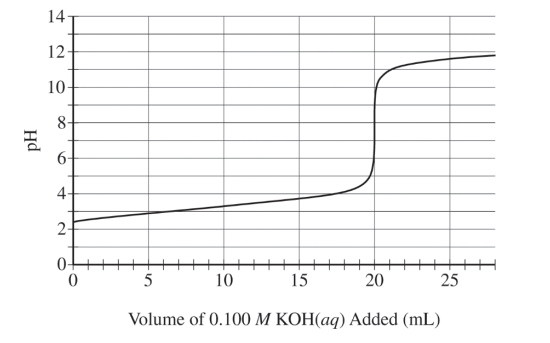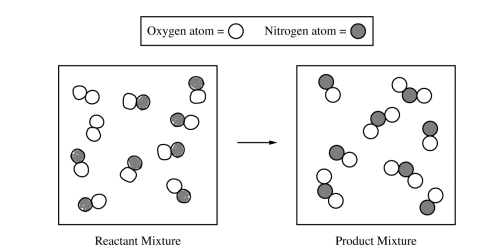Question
2 NO(g) + O2(g) → 2 NO2(g)
A student investigates the reactions of nitrogen oxides. One of the reactions in the investigation requires an equimolar mixture of NO(g) and NO2(g), which the student produces by using the reaction represented above.
(a) The particle-level representation of the equimolar mixture of NO(g) and NO2(g) in the flask at the completion of the reaction between NO(g) and O2(g) is shown below in the box on the right. In the box below on the left, draw the particle-level representation of the reactant mixture of NO(g) and O2(g) that would yield the product mixture shown in the box on the right. In your drawing, represent oxygen atoms and nitrogen atoms as indicated below.

The student reads in a reference text that NO(g) and NO2(g) will react as represented by the equation below.
Thermodynamic data for the reaction are given in the table below the equation.

(b) The student begins with an equimolar mixture of NO(g) and NO2(g) in a rigid reaction vessel and the mixture reaches equilibrium at 298 K.
(i) Calculate the value of the equilibrium constant, K, for the reaction at 298 K.
(ii) If both PNO and PNO2 in the vessel are initially 1.0 atm, will PN2O3 at equilibrium be equal to 1.0 atm? Justify your answer.
(c) The student hypothesizes that increasing the temperature will increase the amount of N2O3(g) in the equilibrium mixture. Indicate whether you agree or disagree with the hypothesis. Justify your answer.
N2O3(g) reacts with water to form nitrous acid, HNO2 (aq), a compound involved in the production of acid rain.
The reaction is represented below.
N2O3(g) + H2O(l) → 2 HNO2(aq)
(d) The skeletal structure of the HNO2 molecule is shown in the box below.
(i) Complete the Lewis electron-dot diagram of the HNO2 molecule in the box below, including any lone pairs of electrons.

(ii) Based on your completed diagram above, identify the hybridization of the nitrogen atom in the HNO2 molecule. To produce an aqueous solution of HNO2 , the student bubbles N2O3(g) into distilled water. Assume that the reaction goes to completion and that HNO2 is the only species produced. To determine the concentration of HNO2(aq) in the resulting solution, the student titrates a 100. mL sample of the solution with 0.100 M KOH(aq).
The neutralization reaction is represented below.
HNO2(aq) + OH−(aq) → NO2−(aq) + H2O(l)
The following titration curve shows the change in pH of the solution during the titration.

(e) Use the titration curve and the information above to
(i) determine the initial concentration of the HNO2(aq) solution
(ii) estimate the value of pKa for HNO2(aq)
(f) During the titration, after a volume of 15 mL of 0.100 M KOH(aq) has been added, which species, HNO2(aq) or NO2−(aq), is present at a higher concentration in the solution? Justify your answer.
▶️Answer/Explanation
Ans:
(a)

| See sample student response above. (8 molecules of NO and 2 molecules of O2) |
(b) (i)
ΔG0 = – RT In K \(K = e^{-\frac{870 J/mol}{(8.314 J mol^{-1}K^{-1})(298 K)}}\) |
(ii)
No, the pressure will not equal 1.0 atm. PN2O3 would only equal 1.0 atm if the reaction goes to completion. |
(c)
Disagree. Because the reaction is exothermic, increasing the temperature of the reaction will favor the formation of the reactants (according to Le Chatelier’s principle). |
(d)

(i)
| See sample response above. (Line segments can be used to represent electron pairs.) |
(ii)
| sp2 |
(e) (i)
20. mL \(KOH\times \frac{0.100 mol KOH}{1000 mL KOH}=0.0020 mol\) KOH added \(\frac{0.0020 mol HNO_{2}}{0.100 L}=0.020 M HNO_{2}\) |
(ii)
| The value of pKa is about 3.4. |
(f)
| NO2–(aq) The titration is past the half-equivalence point; therefore, there will be more conjugate base present than acid. |
Question
A student places a mixture of plastic beads consisting of polypropylene (PP) and polyvinyl chloride (PVC) in a 1.0 L beaker containing distilled water. After stirring the contents of the beaker vigorously, the student observes that the beads of one type of plastic sink to the bottom of the beaker and the beads of the other type of plastic float on the water. The chemical structures of PP and PVC are represented by the diagrams below, which show segments of each polymer.

(a) Given that the spacing between polymer chains in PP and PVC is similar, the beads that sink are made of which polymer? Explain. PP is synthesized from propene, \(C_3H_6\), and PVC is synthesized from vinyl chloride, \(C_2H_2CI\). The structures of the molecules are shown below.

(b) The boiling point of liquid propene (226 K) is lower than the boiling point of liquid vinyl chloride (260 K). Account for this difference in terms of the types and strengths of intermolecular forces present in each liquid.
In a separate experiment, the student measures the enthalpies of combustion of propene and vinyl chloride. The student determines that the combustion of 2.00 mol of vinyl chloride releases 2300 kJ of energy, according to the equation below.
\(2 C_2H _3Cl(g) + 5 O_2(g) → 4 CO_2(g) + 2 H_2O(g) + 2 HCl\)(g) \( \Delta H^0\)=-2300 kJ/mol
(c) Using the table of standard enthalpies of formation below, determine whether the combustion of 2.00 mol of propene releases more, less, or the same amount of energy that 2.00 mol of vinyl chloride releases. Justify your answer with a calculation. The balanced equation for the combustion of 2.00 mol of propene is
\(2 C_2H(g) + 9 O_2(g) → 6 CO_2(g) + 6 H_2O\)(g).

▶️Answer/Explanation
(a) The PVC beads sink. The spacing between chains is similar, but a Cl atom has a greater mass than \(CH_3\).
(b) Both substances have dipole-dipole interactions and London dispersion forces (or propene is essentially nonpolar with only LDFs while vinyl chloride has both LDFs and dipole-dipole forces). Propene contains a CH, group, but vinyl chloride contains a Cl atom. Vinyl chloride thus has a larger electron cloud, is more polarizable, and has a larger dipole moment. Thus intermolecular attractions are stronger in vinyl chloride, which results in it having the higher boiling point.
(c) ∆H°\(=6(-394) + 6(-242)-2(21)=-3858 kJ/mol_{rxn}\) The combustion of 2.00 mol of propene releases more energy.
